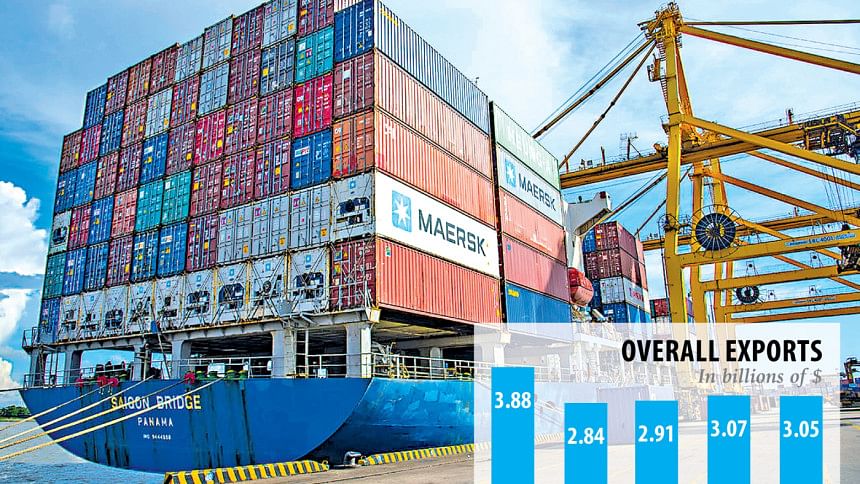Exports fall 10pc in November

Exports declined in the month of November mainly because of poor performance of apparel shipment, in an ominous sign that can thwart Bangladesh’s target to earn $45.50 billion from merchandise shipment in the current fiscal year.
If the trend persists during the remaining months of 2019-20, Bangladesh may also lose its second place in apparel exports to Vietnam.
In November, exports slumped 10.20 percent to $3.05 billion, which is also 17.90 percent shy of the monthly target of $3.72 billion, according to data from the Export Promotion Bureau (EPB) yesterday.
Also, the overall earnings from the merchandise exports between July and November fell 7.59 percent to $15.77 billion, again 12.59 percent short of the four-month target of $18.05 billion.
Lower shipment of apparel items, which accounted for more than 80 percent of the national exports, contributed to the decline.
Between July and November, garment exports declined 7.74 percent to $13.08 billion, missing the target of $15.15 billion by 13.63 percent, the EPB data showed.
Of the garment shipment, $6.80 billion came from the knitwear sector and $6.27 billion from the export of woven items.
The overseas sales of knitwear and woven garments were respectively 8.94 percent and 18.20 percent behind the targets.
Rubana Huq, president of the Bangladesh Garment Manufacturers and Exporters Association (BGMEA), said the export of garment declined by 11.98 percent in November and the export growth of garment has fallen for the fourth consecutive month out of the first five months of the current fiscal year.
“Such a consecutive decline only testifies that the competitiveness of the industry is really endangered,” she said.
Rubana said Bangladesh is not aligned at all with the global competitive scenario.
Particularly, she said, the exchange rate movement of the taka against competitor currencies remains inconsistent and the closure of factories in recent months, especially after the minimum wage hike in December last year, is taking its toll on the exports and the industry.
The latest data from the official source of the US and the European Union showed that Bangladesh significantly lagged behind its competitors in terms of growth of apparel exports in the third quarter of 2019.
In July-September, Bangladesh registered 1.7 percent growth in the US market whereas Vietnam grew by 14.23 percent, India by 3.93 percent, Cambodia by 15.56 percent, and Pakistan by 6.58 percent.
The situation in Europe is equally dismal. Bangladesh’s apparel exports managed to grow at only 0.90 percent, whereas it was 2.98 percent for Turkey, 2.88 percent for Vietnam, and 6.17 percent for Sri Lanka.
Therefore, it is high time for Bangladesh to take a few quick steps so that the apparel export growth can rebound, Rubana said.
A few recommendations on the quick fixes are attempts to get the best exchange rate on RMG export receipts and untangling the complexities in cash incentive, she said.
Rubana said since Bangladesh is operating mostly in the lower-tier of the retail market segment, it is time for the industry to re-think the business model toward diversification from basic to mid- and high-price segment and from cotton to non-cotton items, especially dresses for ladies and girls.
MA Jabbar, managing director of DBL Group, one of the top garment exporters, said a silent recession is going on globally. As a result, people are adopting some austerity measures.
He said Bangladesh’s apparel exporters receive lower prices from international retailers and brands. Moreover, Bangladesh is less competitive than Vietnam because of long lead time.
Jabbar said Bangladesh was supposed to receive more work orders due to the US-China trade war. However, as Bangladesh does not produce high-end products, Vietnam is emerging as the beneficiary of the war.
Frozen and live fish exports declined by 7.62 percent to $235.11 million between July and November, while export receipts from agricultural products slipped 2.69 percent to $446.32 million and leather and leather goods exports gave up 10.03 percent to $391.09 million.
The export of cement, specialised textiles, home textile, and terry towel also declined.
Some sectors, however, performed well during the period. Of them, the shipment of jute and jute goods was up 15.16 percent to $404.79 million.
Bicycle exports went up by 9.81 percent to $36.70 million, the EPB data showed.

 For all latest news, follow The Daily Star's Google News channel.
For all latest news, follow The Daily Star's Google News channel. 



Comments